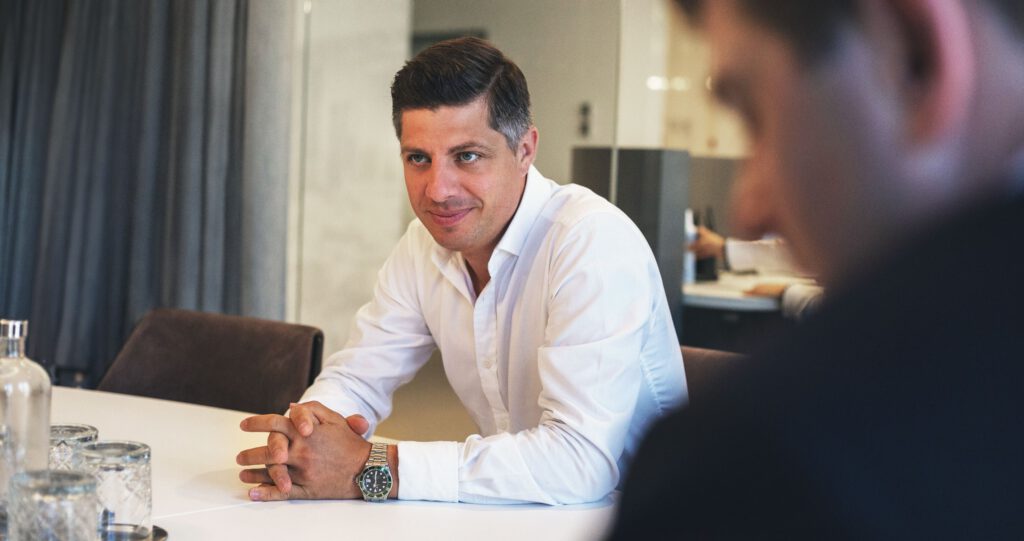How is your employer brand reflected in the recruitment process? What stages does the candidate journey involve — from initial contact to onboarding? And what role do new media and technologies play? We present the answers in a new series in our Valdivia Newsroom. Today we start by looking at the topic from a ‘drone perspective’. We are planning further articles on topics such as how to approach young applicants and the success factors for onboarding.
A candidate journey in 5 sections
Traditional recruitment was a straightforward process. Today, however, the picture has changed significantly. Live formats such as job fairs or speed dating bring searchers from both sides together in an efficient and relaxed manner. For some applications, all you need to do is press a button on your mobile phone. And platforms such as kununu create a completely new dimension of transparency and competition in the labour market. Nevertheless, the candidate journey goes through similar phases in almost every case — even if the 2nd and 5th often do not receive the attention they deserve:
- Initial contacts
are usually made via social media, job platforms, live events or the job offers on your website. Employer branding is particularly evident in this phase in advertising form: with appealing images, texts and — increasingly important — videos
- The interest phase
engages undecided candidates in particular: In addition to the media mentioned above, you can now keep in touch with a job newsletter, via special social media accounts or groups. These media are well suited to conveying the credibility of your employer branding through authentic insights into your everyday working life, for example.
- The application process
should be as simple as possible and only involve a few steps1/2. Clear communication also emphasises the values of your employer brand. For example, prompt feedback and — in the event of unavoidable delays — regular updates have a confidence-building effect. This shows appreciation and keeps applicants interested. Many applicants, including young ones, reject purely online processes2. You should at least enable personal contact on site.
- The Onboarding
covers all further steps after acceptance, from any introductory meetings with the team to familiarisation and the start of regular work. With a structured schedule and an appropriate time budget, you can boost the motivation of your new employees and prevent disappointed resignations.
- After a rejection
, both sides often consider the contact to be over. However, this can be a mistake even if a candidate was unsuitable. Empathetic communication at least limits the risk of negative reviews on kununu & Co. Above all, you should maintain contact with interesting applicants — just in case your ‘first choice’ turns out to be less suitable.
Technologies for a contemporary image
Today, the candidate experience is a key factor with regards to the successful recruitment and the competitiveness of a company. In its ‘Recruiting Trends Report 2024’4/5, the job platform HeyJobs describes the reorganisation of the candidate journey as one of the most important current trends. Using companies such as Marriott, Google and IBM as examples, PsicoSmart, a specialist in HR technology, shows the positive consequences6: greater satisfaction among applicants, more qualified applications and a stronger employer image.
New technologies can help to make the search for and recruitment of new employees faster and smoother and strengthen your image as an attractive employer
- AI technology can be used to personalise communication and speed up processes.
- Mobile optimisation is a must today. Career pages, job adverts and job newsletters only reach most target groups on mobile devices.
- Base content, design and usability on experience from marketing, e.g: Which presentation generates the best click rates and conversions? Where do frequent cancellations occur?
- Video is the most important medium when it comes to conveying information and emotion in equal measure.
The potential of ‘passive searchers’
People who are not actively searching can also be of interest to you: they may have become aware of you through your communication. But they want to take their time and not switch immediately. These ‘passive seekers’ are unlikely to respond directly to a current job advertisement. However, they represent important potential for the future and will be happy to keep an eye on you as an employer … if you offer them the opportunity to do so.
Similar to the group of undecided candidates, you can reach passive job seekers with a newsletter and via social media, but even more so with content-rich media such as a career blog, video reports about your work and taster events where they can get to know your company without any obligation.
Further reading
We have already covered some of the stages of the candidate journey in the Valdivia Newsroom — and summarised them for you here as an overview:
- Stellenanzeigen Job adverts are often still the beginning and core of a search when a specific position is to be filled.
- Social Recruiting Without social recruiting, nothing works today below the decision-maker level.
- Botschafter Ihrer Arbeitgebermarke Employees as ambassadors of your employer brand strengthen trust and complement the loyalty and decision of interested parties, especially in social media.
- Events enable person-to-person contact — as the most natural and often most direct way from the first to the final handshake.
Internal and external impact
The candidate journey in particular shows how fundamentally and comprehensively the world of work has changed in little more than a decade. Factors such as demographic change, the pandemic and AI-based technologies have created a situation that would have been almost unimaginable in the noughties. Today, a positive candidate experience is no longer an optional courtesy, but a process on the quality of which the existence of your company can depend.
It would also be a mistake to only see this as an external effect: Employees get to see how applicants are attracted and treated. This not only colours the general mood, but also influences a very important source of new employees — recommendations from their personal environment.
List of sources
- 61% of applicants want to complete an application in 15 minutes or less Source: ‘Talent Board Candidate Experience Research’ — Society for Human Resource Management SHRM, 2024
- For positions without management responsibility, the application should only include one round: 40% of applicants drop out if the process is multi-stage. Source: ‘Candidate Market Report 2023’ — HeyJobs GmbH, August 2023#
- Around 70% of applicants would like at least one interview in a common room. Source such as 2.#
- ‘The Power Of The Candidate Experience’ — Forbes Human Resources Council, July 2023
- ‘Recruiting Trends 2024’ — HeyJobs GmbH, January 2024
- ‘Technology in Candidate Experience Management’ — PsicoSmart, August 2024
(Image source: istockphotos)










































